Detonation Management – The Key to 2stroke Power and Reliability
a technical paper by Harry and Gerhard Klemm of Klemm Vintage Racing Engines
Overview - For many decades, professional race engine builders have believed that the best racing engine setups where those that can operate consistently on the brink of detonation, without ever crossing the line of going into detonation…. And time has proven that they were half right. Modern data gathering tools developed during the 1990s showed clearly that the best racing engine setups actually detonate 5-15% of total combustion strikes. These same tools allowed engine builders to learn what the detonation tolerance level of any particular engine was (it varies from one engine design to another), and helped them develop tuning tactics that reduced detonation risks without reducing power output. These tools forever changed the way engine builders went about seeking additional power, and forever removed the specter of random detonation related engine failures for racing 2strokes. In short, it was the ultimate game changer in the assured reliability of racing two stroke engines.
The technicians of Klemm Vintage have been building 2 stroke racing engines since the early 1970s, and we have been using these modern “detonation sensor” tools to develop 2 stroke racing engines since 1996. From 1992- 2002, we built numerous 3-cylinder 2cycle PWC race engines that dominated professional PWC endurance racing …. and a large part of that success was thanks to the deto sensor tools we used. Today we can bring the experience of those years of development to the genre of vintage racing 2strokes.
This document about detonation management will be specific to air cooled 2 strokes used in vintage motorcycle and ATV racing applications. We will focus on the tactics we use to construct high output 2strokes that have a measure of reliability with power that is far beyond what was possible “back in the day”. This is done by literally “managing” the rates and risks of detonation.
By far the best technical article we have seen about detonation was written by well known tuner and tech writer, Kevin Cameron. The article is very well worth reading .... Here is a link .... Kevin Cameron Deto
The Tools Used to “See” Detonation - 2stroke motorcycle tuners have long sought a tool that can allow them to see when detonation is taking place, so a failure can be averted before it happens. The first tool used by many was a spark plug temperature gauge (used on many small aircraft) that took it’s readings from a washer between the spark plug body, and the cylinder head. While these gauges offered some helpful info, the response time was far too slow to warn of an eminent failure.
The next tool of choice was an exhaust gas temperature gauge (called EGT) that takes it’s readings from a probe fitted into the exhaust pipe interior, just a few inches away from the piston face. EGTs were a big improvement over the spark plug temp gauge, however the EGT had one big flaw. As detonation was taking place, the terribly damaging heat of detonation was being absorbed by the cylinder head dome and piston crown, and not being “seen” by the EGT several inches away. This created a situation where the EGT would actually show declining temps at the probe, in an engine that was in the process of going into catastrophic detonation …. Not good.
Finally a German company (2D) developed a true adjustable on-board detonation sensor. This deto-sensor has a very special sensor that fits in the location of the spark plug washer. The spark plug is tightened onto this sensor washer to a very specific torque setting. This sophisticated sensor actually “sees” the slightly reduced spark plug seat pressure of a combustion strike.
A proper combustion strike actually reduces the spark plug pressure on the sensor a very small amount. However the high pressure spike of a “detonation strike” lifts the spark plug more, and reduces pressure on the sensor more. The sensor washer feeds all this data to a micro processor that literally counts the percentage of total strikes that are deto strikes, and lights an LED light for the rider to see. The micro processor is adjustable so a tuner can set it to show the LED light for varying percentages of deto strikes. Once the percentages are properly set, a flickering LED light means you are very close to the safe deto strike limit …. A solid bright LED light means you are well outside the safety zone, and you have about 3-5 operating seconds to get out of the throttle before failure. In the truest sense, this was the first tool that warned of an imminent failure, and gave the time to avert that failure,
This tool was commonly used on all the 125/250/500 FIM Gran Prix two strokes until the end of the 2stroke era, and it marked a quantum leap in reduced racing engine failures. The only problem with these deto-sensors is that they cost about $6000, and they don’t “like” excessive vibration or rough treatment….. but they are certainly durable enough for limited periods of development testing both on a dyno and in field testing.
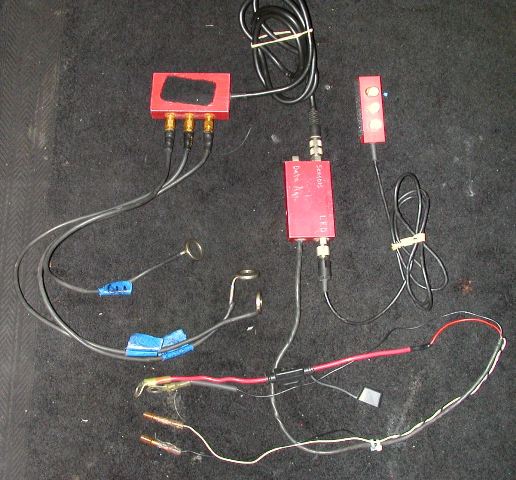 |
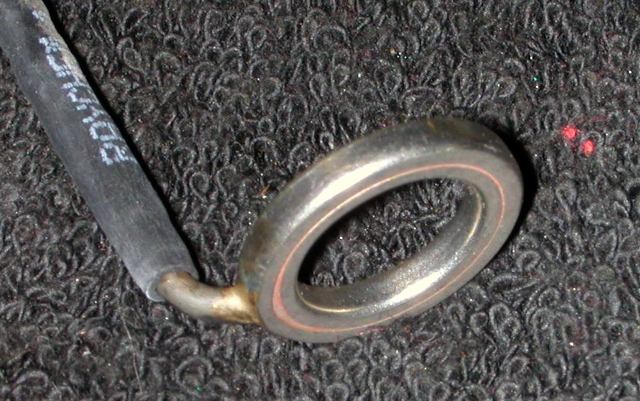 |
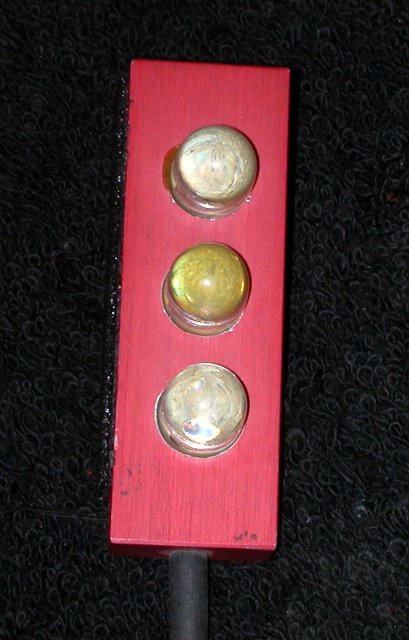 |
| This is the entire deto sensor laid out on a bench top. To be sure it doesn't look like $6000 worth of "stuff" ... but the amount of technology built into the billet aluminum cases of these micro-processor boxes is huge. The system is driven by a standard 12v battery. This is a three cylinder model. | A close up of the very sophisticated pressure sensor that fits under the spark plug. | The LED lights of the deto sensor. |
Glossary - This new tool created some new tuning scenarios that we didn’t yet have words for. With that, we had to create a few new tuning terms …. Listed below are the most important ones.
Deto risk - We refer to “all” tuning adjustments as having a higher deto risk, or a lower deto risk…. Nothing else really matters. The ultimate goal is to make numerous modifications that collectively reduce the deto risk by such a margin, that even a slightly lean fuel mixture will not result in dangerous detonation percentiles…. And “not” deliver a scored piston…. It is a very doable goal.
Target Peak rpm – Refers to the actual peak rpm numbers that the machine can attain “in the field” under full load in high gear.
Full Load Operation - Valid deto testing must be done under full load operation only….. That is, at peak target rpms, in high gear. Running a machine at peak rpms in lower gears has a far lower deto risk than the same rpm numbers in high gear. Deto testing while running in 2nd or 3rd gear is a waste of time, and does not yield worthwhile deto risk information.
Cold numbers - Any tuner that has done extensive dyno or field testing of any kind will tell you that the first run of the day is often the best run that you’ll see all day….. and we call this pass the “cold numbers pass”.
The reason that cold numbers are always best is that the crankcases are very cool, and the fuel/air charge entering them is more dense than when the cases get hot. After 4-5 minutes of full-load operation, the crankcases become as hot as they are going to get. We refer to this as a fully “heat soaked” engine. When a fuel/air charge enters the crankcases of a fully head soaked engine, that charge becomes heated, and it’s density is measurably less than the same fuel/air mixture entering cold crankcases.
This is very important because engine tuning and deto testing needs to be done under racing “heat-soaked” conditions. Road racing and small bore MX engines have the hardest life of all because no part of a their races gets run with “cold-numbers”. On the other hand, drag racing setups seldom experience a full heat soak during their racing passes, and so their deto-risk settings can be much more aggressive.
Torque peak – Horsepower peak – Over run - The formula to figure horsepower is the torque number multiplied by the rpm number. The torque peak of most 2stroke racing engines is a few thousand rpm below the horsepower peak. You would think that most race motors would only rev to the horsepower peak…and then stop revving. In truth, most high rpm 2strokes have the ability to “Over-run” slightly past the horsepower peak rpm number… especially in the lower gears. All of this is important because the highest deto risk is at the peak horsepower rpm number …. And the deto risk drops measurably below and above that rpm number.
Dispelling some Myths
“Piston Seizures are always a sign of lean jetting” …..Wrong. After working with a deto-sensor for a period of time, it becomes abundantly clear that 90%+ of all piston seizures (on air-tight freshly built engines) are not a result of lean jetting ….. but rather a result of the piston super-heating that comes from detonation. “Sometimes” richer jetting can reduce or stave off that detonation …. But not always. We encountered countless situations during our testing when our sensor showed dangerous detonation, but even significant increases in jetting had little effect on staving off the lethal percentages of detonation. The deto sensor helped us to “see” the other tuning issues that were the actual source of our detonation (ignition, compression, etc). Once we solved the true source of the detonation, we could run our Ideal (not over-rich) jetting with no deto at all. It’s also worth noting that if an engine is built with a big enough measure of deto-resistance, it can easily survive being run a bit too lean. Testing with a digital tachometer reveals that this slightly lean setting will offer visible lower peak rpm numbers long before it is lean enough to deliver a seized piston.
“Detonation Always produces Audible Pinging” ….Wrong. There are “some” 2stroke race engines that do emit an audible “pinging” noise when they go into runaway detonation …. But that is the exception, not the rule. On top of that, virtually no 2stroke race motor makes an audible pinging of any kind, when experiencing the slightly elevated percentage of deto strikes that routinely deliver a seized piston.
“Lean Jetting on the brink of piston Seizure gives the best horsepower”…Wrong. This is not true, and it never has been. If you do high gear, peak-load testing with an on-board digital tachometer, you will quickly learn that the jetting that yields the highest “steady” peak rpm hot-numbers is well away from being too lean. In fact, if you do your jetting testing with a load of 110 octane fuel (to get a big margin of deto-safety), you can safely lean out the main jet until you see a very visible loss in peak rpm. The high octane fuel has so much deto resistance that you will see this visible loss in peak rpm long before you are at risk to experience any deto that results in a seized piston.
The best way to reduce Detonation to Manageable Limits
Octane - It bears noting that most vintage air cooled two strokes were sold during a time when premium pump gas was from 98 to 101 octane …. And that fuel had no oxygenate additives nor blended in ethanol. Today’s 91-93 octane premium pump fuels do not offer near the deto resistance of yester-years pump fuels, but “most” air cooled two strokes can still be modified to run reliably on today’s pump gas.
For extreme “full load” applications (road racing, 125 pro MX, sand duning) 91 octane fuel just will not do the job. There is nothing that makes a bigger reduction in deto risk than running higher octane fuel. The very best is 110octane race gas … but this fuel is always expensive, and often hard to find. That said, there are several more affordable and user friendly ways to enhance octane. For more info on this, see our “Fuel Octanes” page. http://www.klemmvintage.com/gasolines.htm
Head Dome Design and Squish Clearance - “Squish clearance” is the thickness of the air gap between the cylinder head dome and the piston crown at top dead center. This clearance is important because the igniting of the fuel mixture “end gases” in this “squish band” is the culprit responsible for causing 90%+ of all detonation. In a perfect head design, the fuel mixture in this very thin squish-band are greatly cooled by nearby surfaces of the piston crown and head. If the squish clearance is too thick, the cooling of these end gases is not sufficient to keep them from exploding, and so they become the source of detonation.
The shape of the combustion chamber, and thickness of squish clearance, have a huge impact on a 2stroke engine’s deto risk. Ideally, a squish band should be shaped to closely match the contour of the piston crown for a 10-20mm width (depending on bore diameter). Ironically, the big majority of air cooled 2strokes of the 1960s-80s era had dome designs that were nothing like this …..And they had head dome designs that ranged somewhere between “not so good, to totally horrible” … no one knows why the manufactures did that. The good news is that these dome shapes and squish clearances can often be modified (by machining) into an excellent deto resistant design. In a few rare cases, the stock dome design is so bad that the stock dome needs to be filled in with weld so a completely new dome design could be cut in.
Volumes have been written about how to calculate “maximum-power dome design and squish clearance”, including computer programs that do the task. We respectfully submit that we have spent more time prototyping and testing domes and squish clearance on vintage 2strokes than “anyone” else there is. In short, there are some good “general parameter rules that will get you a functional and safe result that is within a few percent of what the “supposed ideal” design might be. For vintage racing 2strokes, having maximum deto resistance is far and away more important than having a so-called “optimum-performance” head-dome design.
To be sure the actual compression ratio also has a significant impact on deto risk. For this reason, we consider head dome volume, dome shape, and squish clearances, as a collective of specs that all need to be tailored for the operating RPMs and loads an engine will be subjected to. Finding that ideal mix of these specs is what Klemm Vintage does, and it is a job that is made exponentially easier by testing with the deto-sensor.
Internal Engine Modifications - Besides the re-designing of the head dome and squish clearances, there are several other internal engine changes that can help to significantly reduce deto risks. Since excessive piston crown temperatures are one of the big contributors to the occurrence of detonation, any internal mods that help to reduce piston crown temperatures are very helpful. On our Klemm Vintage engine builds, we always try to take full advantage of any of these deto risk reduction strategies. Among these mods are, reduced piston crown angles, reconfigured transfer ports, and improving heat exchange from the piston to the cylinder wall. While none of these mods alone make a huge reduction in deto risks, collectively they have an effect that is very significant.
Compression vs. RPM - It’s no secret that increasing compression and rpm are two of the most popular ways to increase power. Sadly, these two variables also generate more heat and more deto risk than any other mods you can make. The good news is that most racing vintage 2strokes can deliver 21st century race winning power without having to make the exact same horsepower numbers that were needed to win a competitive 20th century top level pro-class race. Given this, “current day” tuners have the luxury of slightly detuning vintage race engines without giving up any competitive margin.
Based on all our deto testing and hands on experience, the biggest reductions in deto risk come from slightly reducing peak rpms, and this has a big two-fold benefit. Firstly, the reliability of all internal moving engine parts is greatly increased when peak rpms are reduced. Secondly, engines tuned for slightly lower peak rpms can also be tuned to offer broader power-bands that make the machines easier to ride and control. When the powerband is wider, the rider spends less operating time “screaming” the engine to peak revs. It is a win-win scenario for the rider and the engine.
Ignition Timing and Curves - Most ignitions on vintage air-cooled 2strokes were “straight firing” ignitions. Straight firing means that the ignition timing value did not change with RPMS. When the timing was set at 2.0mm BTDC, it fired that value at idle…and at 12000 rpm. Advancing the ignition timing on these straight-firing ignitions resulted in better acceleration, but a very high risk of deto at peak rpms. Conversely, more retarded ignition timings offered a big margin of safety from deto at sustained high rpm applications, but harmed mid-range acceleration.
As two strokes were developed through the late 80s and 90’s, it was learned that the best overall power was had with an ignition had an “advance-retard curve”. These ignitions offered a very retarded timing value that made for easy starting with very little “kick-back”. Once fired up, as rpms increased, the ignition timing would automatically advance at a very rapid rate to a peak advance somewhere in the 6000-7000rpm window. After the max advance was achieved in mid-range, the ignition was programmed to progressively retard the ignition timing as RPMs increased. These advance-retard ignitions offer the best of both worlds …. Excellent mid-range power, along with a big reduction of deto risk at peak rpms.
Today there are aftermarket manufacturers that make modern “advance-retard” ignitions for virtually every vintage 2stroke application. These ignitions are a bit costly, but for anyone building a competitive level vintage 2stroke racer, this is some of the smartest money you can spend. Here are links to quality ignition makers : http://www.pentonracingproducts.com/ http://www.hpi.be/
“Air” Heat Dissipation - All “air cooled” two strokes are equipped with top end “fins” intended to exchange away the engine heat to the air passing over the cylinder and head fins. However these top ends can be altered and prepared in ways that greatly increase the effects of this air exchange.
Pavement applications offer the best opportunities for improving heat exchange. Below are some of the tactics we used to keep our AHRMA 350cc Kawasaki singles cool enough to survive 15 minutes at 8500rpm.
Head Scoop - Both Suzuki & Yamaha produced middleweight 2stroke multis during the 1970s that had built in cylinder-head scoops to “supposedly” improve cooling. While those scoops looked very sporty, they did a very poor job of directing any meaningful amount of added cooling air to the areas that needed it most. (PHOTOS)
For our Kawasaki 350 and 500 AHRMA machines, we fabricated some very simple … but very effective head scoops that delivered the maximum possible dose of air to the areas where it was most needed. In short, these very simple scoops we designed to deliver a big dose of air toward the center dome of the cylinder-head, where the heat is greatest. These scoops were easy to make, easy to remove (for maintenance) and greatly helped to reduce the deto risks at the high speeds we road raced at. It’s unclear whether such scoops would offer as much cooling effect in an MX or flat-track atmosphere (given the dirt exposure)….. but they sure can’t hurt.
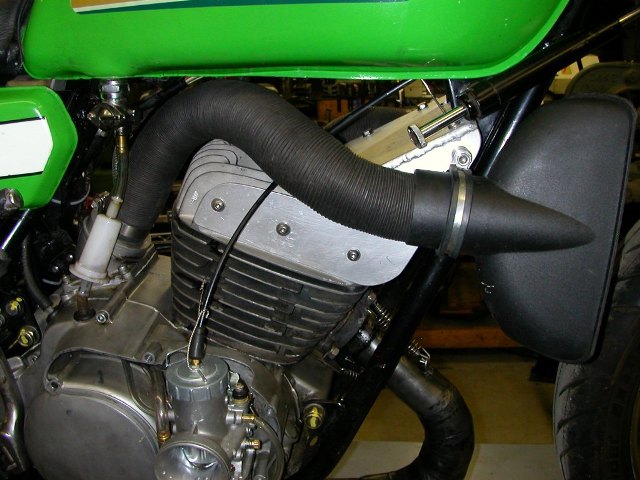 |
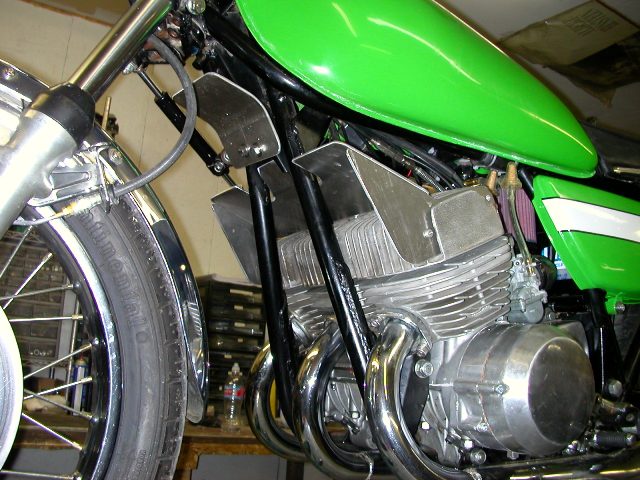 |
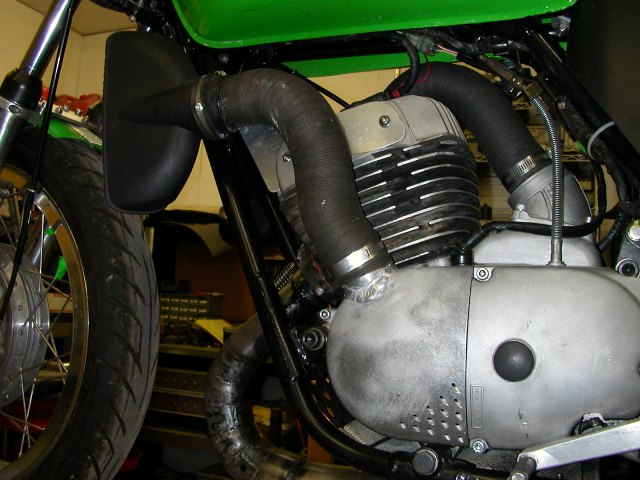 |
| The head scoop on our 350 Bighorn AHRMA Championship Production racer. It is easy to make, easy to remove, and drives a big volume of air towards the head "forward" of the combustion chamber. We figure we are going to push that piece of wind anyway, so we may as well put he air resistance to a good cause. | A similar arrangement for our AHRMA H1 Production racer. The center panel removes quickly with just 4 bolts. Like the Bighorn scoop, air is directed toward the combustion chamber area. The added center scoop helps direct badly needed cooling air to the cylinder whose cooling are is being blocked by the front wheel. | The Bighorn Street-Fighter with full cooling. The ignition cover is "vented at the lower right to allow exit of the hot air. The air intake (yes it's a Shop-Vac nozzle) is high enough to avoid the ground level road-flak that might make it's way into the ignition area if we just drilled the ignition cover. |
Other Air Cooling - Very often, the “ignition side” cylinder of multi engine has a much higher deto risk than the other cylinders . 2stroke ignition magnetos generate a tremendous amount of heat that is absorbed by the crankcases, and ultimately affects the density of the incoming fuel/air charge entering that adjacent crankcase area. This makes “ignition cooling” a very real and meaningful part of reducing deto risk for the ignition side cylinder. Some pavement racing technicians simply drill holes in the ignition cover to improve this cooling. Unfortunately, there is plenty of road flack and debris that gets kicked up from the pavement at that ground level that can make it’s way into the ignition electrics. To help reduce this “road flack” problem, we welded a 2” tube to our ignition cover, and rigged up a scoop connected via a standard automotive 2” flex hose. The costs of this setup are very low, and the amount of air passed over the hot generator electrics is very high. This air cooling not only reduces deto risk, but it also improves the long term life and performance of the electrics themselves.
Case Cooling - Our Kaw 350 Rotary valve motors offered a uniquely good opportunity for additional cooling of the crankcases. These engines have a sealed air passage way that was originally intended to bring air from the air filter to the carb in a sealed interior passageway. Since we were free to eliminate the air filter on our road racing Bighorns, we decided to use this passageway to cool the crankcases. Like the ignition, we rigged up an inexpensive scoop and 2” flex-hose to drive air into his interior passageway to help cool off the crankcases themselves. While this might sound a bit outlandish, it has proven temperature reduction benefits.
When SeaDoo decided to build a hardcore racing platform of it’s 951cc twin cylinder PWC in 2001, it was faced with trying to manage a huge deto risk problem. The marketing dept, mandated that this machine would have to be able to run reliably on 91octane pump gas. After trying countless ignition timing/compression ratio tactics with no success, the engineers decided to try attaching a water jacket to the lower crankcase to reduce net engine temperatures. Immediately, the water-cooled crankcase dramatically reduced engine temperatures and the overall deto risk to the point where the platform could easily deliver pro racing horsepower numbers while running on 91 octane pump fuel. The lesson was…. Cooling is beneficial …. No matter where you do it.
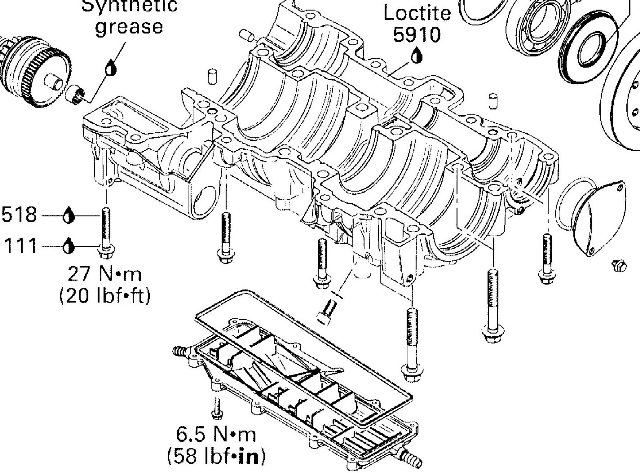 |
This diagram image shows the water-jacket plate
that the Sea Doo engineers attached to the bottom crankcase half.
The water circulated through this water jacket dramatically reduced net
engine temperatures .... and so too detonation risks. This same water-jacket was employed on all the emissions compliant "direct injection" engines that SeaDoo fitted into numerous other models. |
Deto in Twins and Triples - Twins and triples require a very different thought line when tuning to manage deto risk. The very first thing that is learned about “multis” when testing with a deto-sensor is that no two cylinders on any engine has the same deto risk…. And this varying deto risk makes the deto-sensor a mandatory tool. The Kawasaki H1 500 triple offers one of the most gleaning examples of this. We constructed a Kawasaki H1 500 for AHRMA Production Class road racing (stock pipes & carbs required by the rules). Modified H1’s are motorcycles with several nasty reputations, and random piston seizure is one of them. Using a deto-sensor, this problem becomes forever a thing of the past.
About Multi Piston Seizures - One of the most un-nerving things about deto failures in multis is that they often serve little or no notice to the rider until the very moment of failure … here is why.
On the Kawasaki H1 500 triple, the deto risk of the center cylinder is “a lot” greater than the other two cylinders. When the engine is fully heat soaked and running at 7000+rpm, the center cylinder begins to go into mild detonation, while the outside cylinders are deto-free and happy. As the temps of sustained peak rpm operation increase, the center cylinder goes into lethal percentages of detonation, while the “still happy” outside cylinders are firing at full song with no problems at all. During this time, the deto-free outside cylinders are masking the power loss of the struggling center cylinder, and they drag the center cylinder along with them, right up to the millisecond that the struggling center cylinder seizes or holes a piston.
If the H1’s center cylinder were a single cylinder engine working all by itself, the rider would have easily felt the drop off in power (from detonation) long before the failure risk became critical mass. An observant rider on such a single cylinder setup might easily have been able to release the throttle to avoid a failure before it happened. However with the two other “perfectly happy” cylinders pulling the center cylinder along, there is no rider on earth with enough talent to “feel” this failure before it happens. The very same scenario plays out for twin cylinder motors. It should be understood that there is “NO” 2stroke twin whose two cylinders have exactly the same detonation risk. There is “always” a deto prone cylinder.
About Multi Cylinder “Balance” - There is a long held belief among some engine builders that all specifications in a 2stroke multi must be exactly identical to maintain some sort of “balance” …. And they are half right. The “true” number-one priority in a 2stroke multi is to balance the “deto-risk” of all the cylinders…. Everything else is secondary. In our race winning 3 cylinder PWC endurance racing engines, we often ran different compression ratios and different carb jetting in all 3 cylinders in an effort to get all three cylinders to have exactly the same deto-risk at peak-load operation. As time went on, the oem manufacturers caught on to this same mindset. The later versions of Yamaha’s 3 cylinder PWCs had an ignition that offered a different advance/retard curve for each cylinder, as well as different jetting for each cylinder, in an effort to perfectly balance the deto risk. In their later twin cylinder PWCs they also staggered the compression ratios towards this same goal. The lesson is that a balanced “deto-risk” is the only thing that matters.
Back to our Kawasaki H1 Production racer, we eventually achieved equal deto risk among all three cylinders by “staggering” the compression ratios and jetting. Once we had “managed” the deto risk of the center cylinder, we saw that the next highest deto risk was on the ignition side cylinder (no surprise there). In the case of our H1 500, the deto risk of the ignition side cylinder was only a problem during sustained operation over 7500rpm (as in a road racing application). Even so, we used this setup to make our 115mph 8000rpm runs at Bonneville, but those passes only last 50-60 operating seconds at full load. In a pass that short, the engine never experienced full heat soak, and so we had no left cylinder deto problems.
After the record passes, we filled our H1 with 91 octane pump gas and rode it the 100 miles from the pits of Bonneville to Miller Motorsports Park. On a ride this long, the air scoops we built to get added cooling air would definitely play a big part in staving off detonation. The majority of this ride was cruising at 5000rpm / 70 mph, with occasional short runs to 7500 to pass traffic. These high rpm passing bursts were short enough to not cause any deto risk … even with the temps of sustained cruising. On such a ride, the deto-risks of all three cylinders was so low that, there was never any piston scoring risks. Given that, the slightly higher “sustained-high-rpm” deto risk of the left cylinder was a problem that we didn’t need to solve unless we went to a track day or a road race. We would later be able to address that temperature problem by air-venting the ignition, or slightly reducing the compression ratio..

